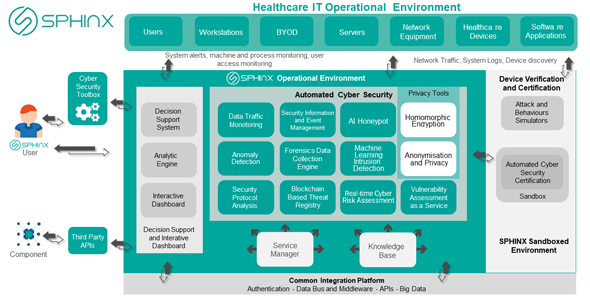The Architecture of the SPHINX Platform
October 2019

The SPHINX Platform comprises a set of universal cybersecurity solutions for the healthcare industry that ensures not only the protection of the information ecosystems of healthcare organisations but also the safeguard of the patients data's privacy and integrity.
The design of the SPHINX Platform's architecture considers mostly the usefulness of the solution for its key users, specifically the system administrators and cybersecurity technicians that work in healthcare organisations. In this context, criteria of easiness of use, understanding, interaction and navigation have been applied to the design and structure of the modules presenting information, with a clear objective of promoting the easy interaction with the system users and preventing the so-called operator fatigue.
From the functionality perspective, system users benefit of important capabilities that aim to facilitate not only the control and monitoring of the regular operation of the organisation's information technologies and systems ecosystem, but also the prevention and response to the cybersecurity vulnerabilities, threats and incidents affecting the ecosystem. Among the most iconic functions, the tools to assess cybersecurity vulnerabilities and to certify components, devices and applications take point. Also relevant are funtions on interactive dashboards for the cybersecurity data, the presentation of alerts to support decision-making processes and the assessment checklists to validate the system's state of readiness in face of known and forecasted vulnerabilities and threats.
Manking available these utilitarian features, the SPHINX Platform is based on an architectural design of 21 components, grouped in the modules of Verification and Certification of Devices and Applications, Automated Assessment of Cybersecurity Risks and Vulnerabilities, Support Decision System and Cybersecurity Toolbox. These modules are then articulated through a Common Integration Platform and made accessible to third-parties through a set of APIs that allow these parties to validate the conformance of their own devices and applications to the SPHINX cybersecurity standards before they are integrated into the IT ecosystem of healthcare organisations.


